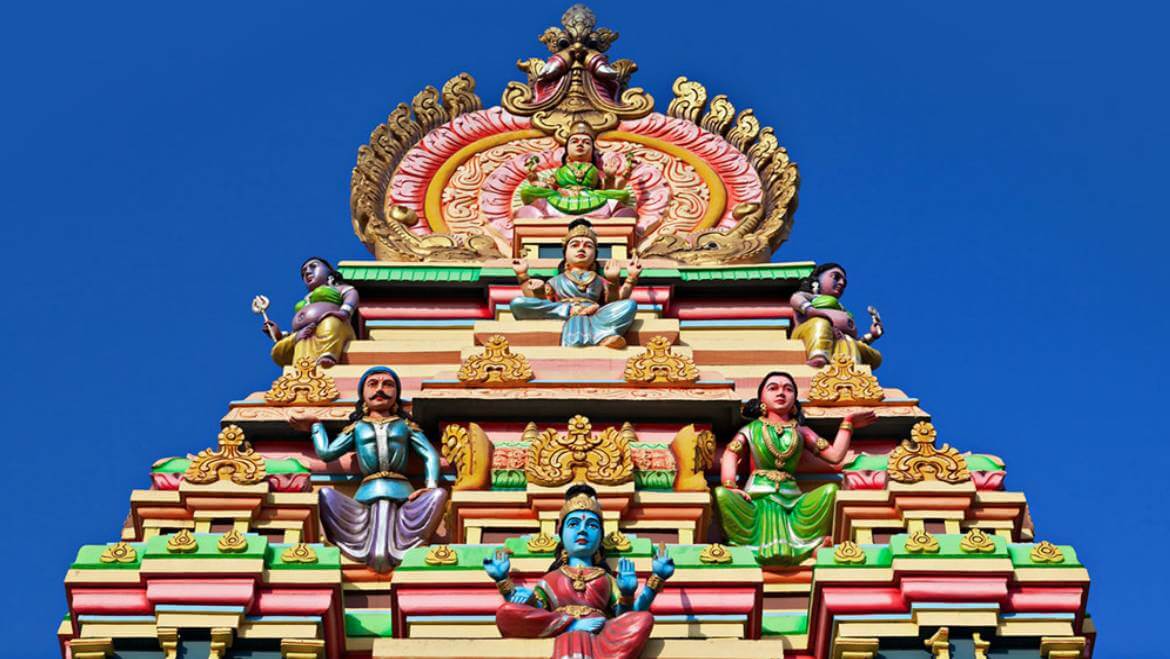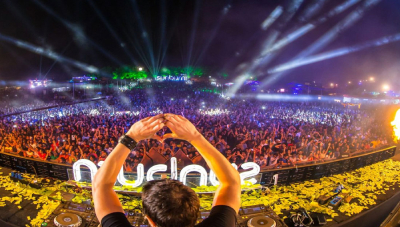Welcome to the world of Other-Worldly!..
Bygone times brings bygone glories, glories of the past when the grandeur of royal kings were adorning each corner of India in the form of astounding forts, visually appealing temples and tales of valour. When India used to tell tales through various sculptures of artistic artisans and the mystical stories and legends of saints and Gods used to fine tune the spirit of every Indian, which it still does.
Today we are going to talk about the bygone glory one such a land. The land of many tales that are mystic and other-worldly; the land where elaborate architecture and brilliant sculptures of its ancient temples, leave all its tourists spellbound with their astounding beauty, it’s the abode of delightful temples, the abode of other- worldly – Tamil Nadu.
A trip to these temples showcases the opulent and lavish tastes of the erstwhile royal kings, be it Pallavas, Cholas or Nayakas. Standing tall as the backbone of the Tamil culture, these temples are today India’s precious jewels adding to its rich heritage.
Tamil Nadu that not only provides you a great spiritual experience but also gives you a chance to revel in their mesmerizing designs, still speaking stories of their glorious past. Here is a list of 20 Top temples of Tamil Nadu for the divinely inspired travellers.
20 Most Popular Temples in Tamil Nadu
- Meenakshi Amman Temple, Madurai
- Adi Kumbeswarar +Temple, Kumbakonam
- Brihadeeswarar Temple, Thanjavur
- Sri Ranganathaswamy Temple, Srirangam
- Sri Rajagopala Swamy Temple, Mannargudi
- Jambukeswarar Temple, Thiruvanaikaval
- Kanchi Kailasanathar Temple, Kanchipuram
- Ekambareswarar Temple, Kanchipuram
- Ramanathaswamy Temple, Rameshwaram
- Mayuranathaswami Temple, Mayiladuthurai
- Kapaleeshwarar Temple, Chennai
- Monolithic Rock Temples, Mahabalipuram
- Papanasam Temple, Tirunelveli
- Srivilliputhur Andal Temple – Virudhunagar
- Nagaraja Temple, Nagercoil
- Kumari Amman Temple, Kanyakumari
- Thillai Nataraja Temple, Chidambaram
- Annamalaiyar Temple, Tiruvannamalai
- Sripuram Golden Temple, Vellore
- Bala Murugan Temple, Siruvapuri
Recommended Tour Packages
Meenakshi Amman Temple Madurai – An Ancient Divine Destination
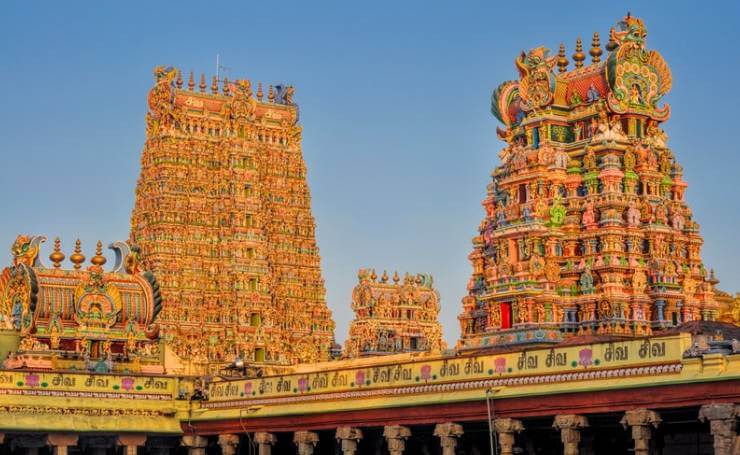
Dedicated to Goddess Parvati in the form of Meenakshi and her consort, Lord Shiva in the form of Lord Sundareswarar, the Meenakshi Amman Temple is one of the most ancient and famous temples not only in Tamil Nadu but, in entire India.
According to historical and archaeological records, the temple was originally built around 6th century AD and the major portion of it was damaged in 14th century by the Muslim invaders in India. The present structure of the temple dates back to the 16th century when it was again restored to its pristine glory by the Nayak rulers.
Let’s talk about Architecture
The temple is a masterpiece of Dravidian architecture. The richly sculptured and decorated ‘Gopurams’ of the temple are its major highlight that can be seen from even a far-off distance. Adorned with thousands of figures of gods, goddesses and demons, the Meenakshi Amman Temple is no less than an architectural marvel.
Highlights
Intricately carved figures and scenes depicted from Indian mythology in the halls add to the artistic charm of the temple. Scenes of ocean of milk being churned by devas and asuras, nine heads Ravana playing veena, Rishi Markandeya hugging Shiva Lingam and wedding ceremony of Sundareswarar & Meenakshi are few of the sculptures worth noticing when you are inside the temple premises.
Popular Festival
The temple today sees a footfall of thousands of devotees and tourists every day that raises to around 1 million during the annual Meenakshi Thirukalyanam festival celebrated in the months of April-May.
Other Interesting Blog to Read
Adi Kumbeswarar Temple Kumbakonam – Royal Cholas Rich Legacy
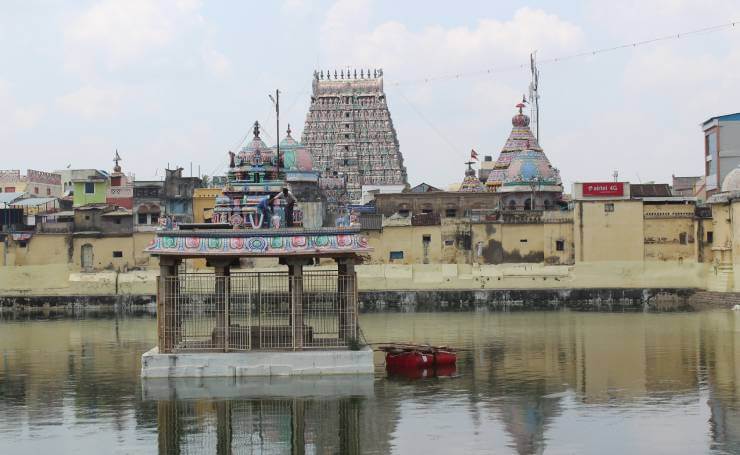
The grandeur of Chola dynasty is still intact in the form of divine Adi Kumbeswarar temple. It’s an exquisite Dravidian style masterpiece which was renovated by Govinda Dikshitar, chief of Achutha Nayakar of Thanjavur in 16th century AD. The temple is dedicated to Lord Shiva.
Holy Domain to embrace Ethereal
The temple of Adi Kumbeswarar is also considered as the 26th Paadal Petra Sthalam during Chola Period. Devotees from all over the world take bath in the Potramarai tank during Mahamaham festival which is celebrated once in every 12 years (It is called as Kumbh Mela in North).
The divine Shiva Lingam will blow your heart away, it is narrow at the top like a needle and broad at the bottom. On the left side of Kumbeswarar, his consort Goddess Mangalambika showers her divine blessings to the devotees.
Apart from the main shrines, shrines of Lord Murugan, Lord Ganesha, Lord Kiratamurati and others adorn the temple premises.
Divine Myths
When the curtain of life of the world was about to fall due to Tsunami, Lord Brahma asked Lord Shiva to know from where he had to start the creation of mankind. Lord Shiva suggested that sand collected from various sacred places should be placed in a magic pot and then leave the pot in water.
The pot stood in the place where the great temple of Kumbeswarar stands today. Lord Shiva shot an arrow on the pot and the nectar from the pot spread to all directions which was already mixed with sand and became a Linga. That Lingam is called Kumbeswarar.
Temple Timings – 6:00am- 12:30pm and 4:00pm – 9:30pm
Other Interesting Blog to Read
Brihadeeswarar Temple Thanjavur – One of ‘Great living Chola Temples’
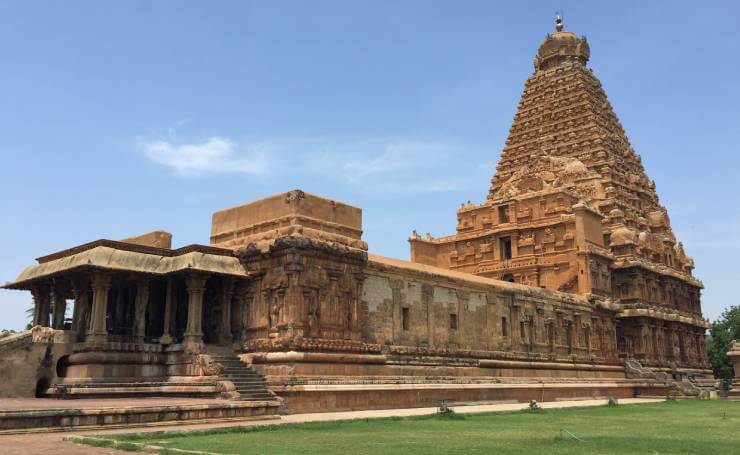
The ‘Brihadeeswarar Temple’ is a delightful abode of Lord Shiva and is located in the Thanjavur district of Tamil Nadu. It is one of the largest temples in India. This brilliant creation of the Chola dynasty in the 11th century AD stands tall as a testimony to the opulence and grandeur of the Chola rulers.
Today, the temple enjoys the status of a UNESCO World Heritage Site under the list of ‘Great Living Chola Temples’ and is visited by hundreds of thousands of devotees and tourists every year.
Architecture Glory
The temple tower is 216 ft long which is considered as the tallest temple tower in the world. The ‘Kumbam’ or the apex structure on top of the Vimana, weighing 80 tonnes carved from a single granite, just adds to the magnificence of the entire structure.
Also, the Brihadeeswarar Temple has another feather to it with an acclaim of being the world’s first temple completely built from granite. With no granite quarry within 100 km. radius of the temple, a visit to this temple definitely makes one wonder about the logistics and efforts that must have been required to transport tonnes of granite to this site.
Just Imagine!
Not only transportation, just imagine how such a heavy rock must have been first carved owing to the fact that granite is one of the hardest stones to be cut, and then later on embellished on top of a 216ft tall Vimana during the times when the technology was just in its early stages?
Temple Timings – 6:00am to 12:30pm and 4:00to 8:30pm
Also Read: Pilgrimage Tourism in Tamil Nadu
Sri Ranganathaswamy Temple Srirangam – Spiritual Peace and Wonderful Architecture
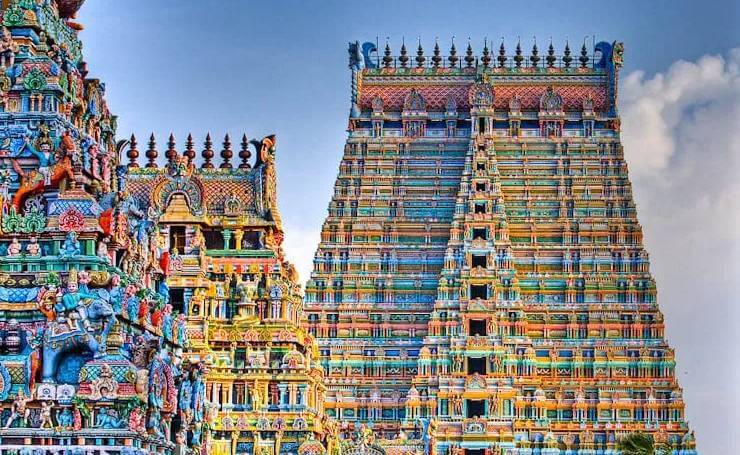
Dedicated to Lord Vishnu, the ‘Ranganathaswamy Temple’ located on the Srirangam Island of the Tiruchirappalli city in Tamilnadu, is another masterpiece of Dravidian architecture. Spread across an area of over 150 acres, the temple has 49 sub-shrines and is dotted with 21 brilliantly carved Gopurams (tower gateways) with the main or the ‘RajaGopuram’ standing tall at 236 ft. making it the tallest Gopurams in Asia.
Temple Township
It is also only one of its kind shrines where you will find a unique mix of a temple and township co-existing; a part of the temple is actually dedicated to temple activities whereas the remaining portion serves as a township for humans.
The temple also has 7 prakaras or enclosures with the presiding deity of Lord Vishnu in the form of Lord Ranganathaswamy reclining on five-headed serpent, enshrined in the innermost prakara. The tower above the innermost prakara is in the shape of ‘Om’ and is completely plated in Gold.
Counted as the first amongst the 108 ‘Divya Desams’ or holy abodes of Lord Vishnu, the temple draws uncountable pilgrims and tourists every year.
Let’s Revive the History
The exact date of the temple’s consecration is still not known but, according to archaeological records, the original structure of the temple dates back to the 10th century when the region was under the rule of the Chola dynasty.
In the 14th century, the temple was plundered of its wealth by Muslim invaders and was again restored to its original grandeur by the Vijayanagara and Nayaka rulers in late 16th century.
What’s in it for you?
- Soulful Architecture: Magnificent architecture, delicate carvings, exquisite sculptures and brilliant frescoes of the temple, even today give you a deep insight into the superb skills of the then architects, sculptors and artisans.
- Artistic and sublime views: During your visit to the temple, you just cannot miss the thousand-pillared hall that can leave anyone awed with its artistic brilliance; the exquisitely carved figures of horses standing on their rear legs depicting war scenes on the base of these pillars offer a true spectacle.
Temple Timings – 6:00- 12:00pm and 6:00pm to 9:00pm
Other Interesting Blog to Read
Sri Rajagopala Swamy Temple, Mannargudi – Lord Krishna’s Grand Abode
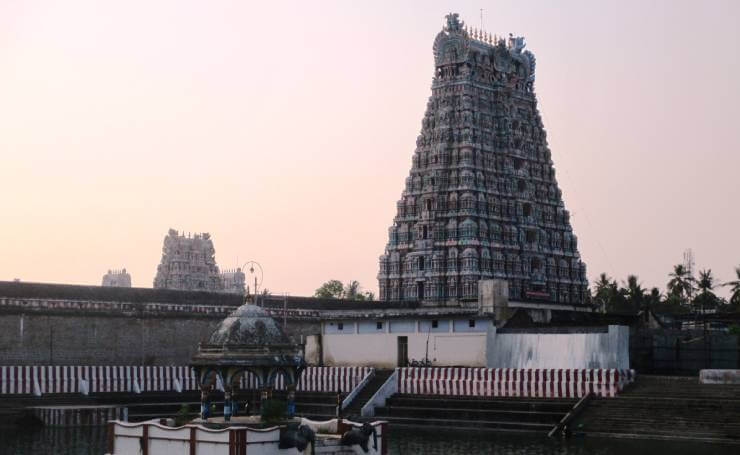
Located in the town of Mannargudi the divine temple of Rajagopala Swamy is one of the most popular shrines of Lord Krishna. The temple is also known as Guruvayoor by Hindus. It is one of the most popular vaishnavite temples in India.
What’s the Appeal?
Mesmerizing stone Inscriptions, 154ft gateway tower – Rajagopuram and the largest temple tank Haridra Nadhi gives the most relaxing vibes to rejuvenate the soul and mind-boggling views for visual treat.
Famous Festival
The most popular festival of Sri Rajagopala Swamy Temple is the Chariot Festival which is held in the month of June-July.
In the Legends- Reason behind the Tusk in the left hand of Lord Krishna
According to a legend Lord Krishna killed a wild elephant named Kuvalaya Peetam who was actually Kansa (Lord Krishna’s maternal Uncle). He wanted to kill Lord Krishna’s elder brother Balrama in the form of an elephant but before that Lord Krishna killed the wild elephant and held one enlarged tusk in his left hand.
Another Legend
The main sannidhi of the temple displays 32 forms of Lord Krishna. According to a legend Lord Krishna gave darshan to two sages Paravasudeva and Raja Gopalan in 32 forms.
Temple Timings- 6:30am to 12:00pm and 4:30pm to 9:00pm
Other Interesting Blog to Read
Jambukeswarar Temple, Thiruvanaikaval- Divinity of Jambu Tree
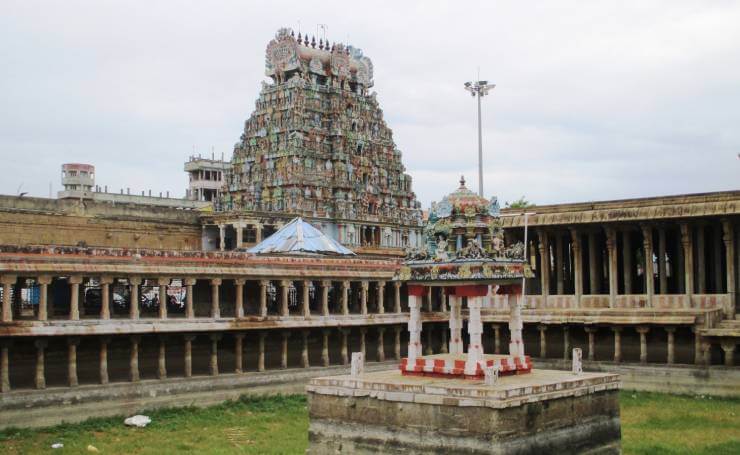
Located on the Srirangam Island of Tamilnadu is the ‘Jambukeshwara Temple’ dedicated to Lord Shiva. Built during the Chola period this temple is a brilliant example of Dravidian style of architecture. It has 7 tiered Gopuram adorned with delicate carvings which depicts the artistic grandeur of Chola Kingdom.
Shiva Lingam is in the form of Appu Lingam (water lingam) and there is an underground stream flowing underneath the Shivling from which water continuously flows out.
Myths of Significance
According to mythological legends, Goddess Parvati in the form of Akilandeswari performed a great penance under the ‘Jambu Tree’ that is believed to have grown from the head of a meditating saint. To perform the Pooja, she made a lingam from the water of River Cauvery flowing by. Impressed with the devotion of Parvati, Shiva gave her darshans and taught her Shiva Gnana.
Enacting the Traditions
Enacting the penance of Parvati as Akilandeswari worshipping Lord Shiva, every day during noon, the priest of the temple dresses as a female dressed in saree and offers prayer to Lord Jambukeswarar. This noon prayer is attended by hundreds of devotees every day and provides a great insight into few unusual Indian traditions and customs to those travelling to India for the first time.
Temple Timings- 6:00am to 1:00pm and 4:00 to 9:30pm
Other Interesting Blog to Read
Kanchi Kailasanathar Temple, Kanchipuram
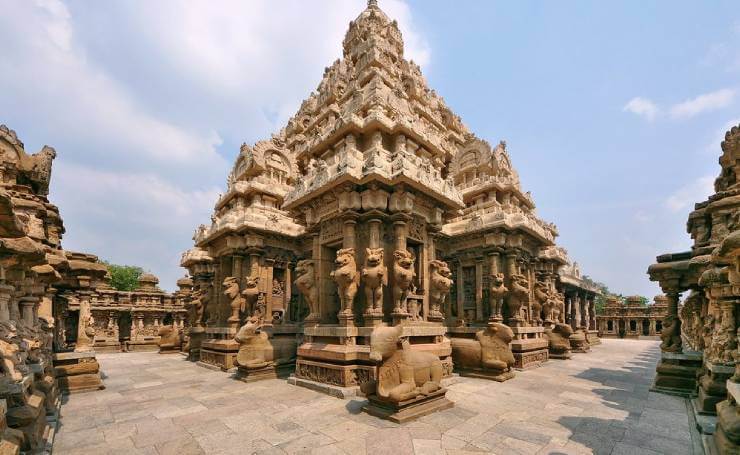
Kanchipuram, the ancient town of Tamil Nadu has been luring divinely inspired travellers to its divine shores where temples tell the mystic tales of Gods and behind their creation the grandeur and artistic brilliance of Pallava Dynasty. You will see some of the best temples from the period of Pallavas. The city’s dravidian heritage and glorious past will be etched to your soul once you visit this fascinating piece of wonder. The two prominent temples in Kanchipuram are –
- Kanchi Kailasanathar Temple
- Ekambareswarar Temple
Located in Kanchipuram district of Tamilnadu, the ‘Kanchi Kailasanathar Temple’ is another one of the most famous pilgrim centres in South India. Dating back to the late 7th century-early 8th century, the temple is believed to have been built under the reign of the Pallava Dynasty.
Artistic Architecture
Carved entirely out of sandstone, the temple is the oldest temple in Tamil Nadu dedicated to Lord Shiva with its main sanctum enshrining a 16 sided Shivling made of a black granite. The architecture of the temple again showcases a brilliant Dravidian style with a delicately carved pyramidal shape tower on the main sanctum and 58 small Shiva shrines enclosed inside the complex.
Major Highlights
Prominent highlights of the temple are undoubtedly, the beautifully carved sculptures of Lord Shiva and his consort Goddess Parvati in different dance postures that can be seen adorning the inner walls. Standing tall as a symbol of grandeur of the Pallava kings, the ‘Kanchi Kailasanathar Temple’ today, attracts hordes of pilgrims from different parts of the country, especially on the occasion of Maha Shivratri when devotees throng here to seek the blessings of the God.
Other Interesting Blogs to Read
Ekambareswarar Temple, Kanchipuram- Ethereal Vibes
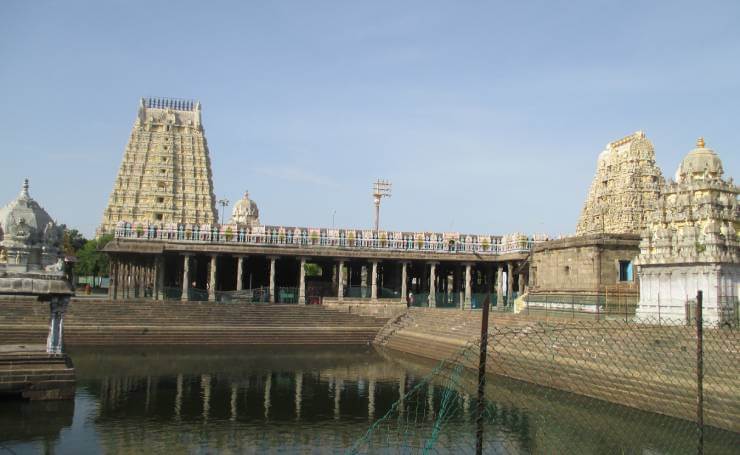
The ‘Ekambareswarar Temple’ attracts thousands of pilgrims and other tourists from different parts of India and abroad. Counted amongst five ‘Panch Bootha Sthalas’ (five elements of the universe), the temple is dedicated to the element, Earth and holds a great religious significance for devotees of Lord Shiva.
Goddess Parvati’s Penance
As per mythological beliefs, Goddess Parvati performed a penance here under a sacred mango tree, for Lord Shiva with a Shivling made of sand. Pleased with her devotion, Shiva appeared before her and came to be known as Ekambareswarar or the ‘Lord of Mango Tree’.
Astounding Architecture
The temple is believed to have been existing since 600 AD but the present structure is said to be dating back to the 11th-12th centuries. The architecture of the temple showcases a signature Shaivite structure with a lofty Gopuram, 5 concentric circumambulatory enclosures. The 1000 pillared hall adorning carvings of 1008 Shiva Lingam is believed to be added by the Vijayanagara kings during the 15th century. The inner sanctum houses the Prithvi Lingam.
Sacred Tree
The sacred mango tree, believed to be more than 3000 years old, can be seen in the temple premises. The speciality of the tree is that it bears four different types of Mangoes in four different seasons in the year.
For anyone on a pilgrimage tour in South India, a visit to the Ekambareswarar Temple provides for a great spiritual experience.
Temple Timings- 6:00am to 12:30 and 4:00to 8:30pm
Other Interesting Blog to Read
Ramanathaswamy Temple Rameshwaram- God’s Own Temple
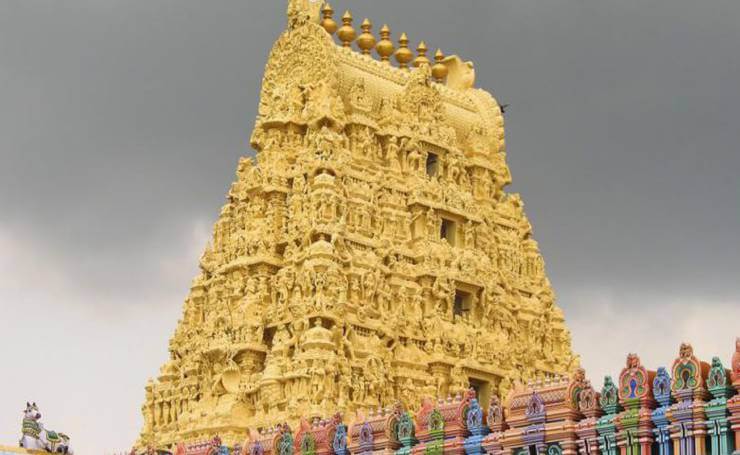
One of the four primary pilgrimage destinations (‘Char Dhams’) for all Hindus across the world, the ‘Ramanathaswamy Temple’ is swarmed by hordes of pilgrims every day. Besides being one of the holy ‘Chardham’, the temple is also counted amongst the 12 sacred Jyotirlingas of Lord Shiva.
Legends Divine
According to mythological legends, the story associated with the Shivling enshrined in the main sanctum of the temple goes back to the times of Ramayana. It is believed that after returning from Lanka, Lord Rama wanted to absolve his sins of killing the demon Ravana who was also a great Brahmin and scholar.
In order to do so, he decided to worship Lord Shiva and asked Lord Hanuman to get the biggest Shivling from the Himalayas. As it took very long for Hanuman to get the Shivling, and seeing the auspicious time for prayers being run out, Rama’s wife, Goddess Sita built a Shivling from sand.
The same Shivlinga, known as ‘Ramalinga’ is believed to have been residing in the sanctum of the Ramanathaswamy Temple for centuries. Enshrined next to Ramalinga is the ‘Viswalingam’, the Shivlinga that was brought by Hanuman.
As per the legends, Lord Rama seeing Hanuman disappointed, ordained that for any devotee visiting Rameswaram, the holy Yatra would be successful only if he first pays his obeisance to Vishwalinga and since then, all the rituals are first made at Viswalingam and then at Ramalinga.
Alluring Pillars
Located on the serene island of Rameswaram in Tamil Nadu, the structure of this temple is believed to have been built during 12th century CE by the Pandya rulers. The tallest of its 4 Gopurams stands at the height of 126 feet metres and is built in typical Dravidian style.
The temple is also acknowledged for housing the longest corridor hall in India made of almost 1000 intricately carved granite pillars. A colossal statue of Nandi 6 metres tall also grabs the attention of many.
A visit to the Ramanathaswamy temple not only provides you with an unmatched spiritual experience but also gives you an opportunity to witness the grandeur and opulence of the kings in the times gone by.
Temple Timings – 5:00 am to 1:00 pm and 3:00 pm to 9:00 pm.
Other Interesting Blog to Read
Mayuranathaswami Temple Mayiladuthurai
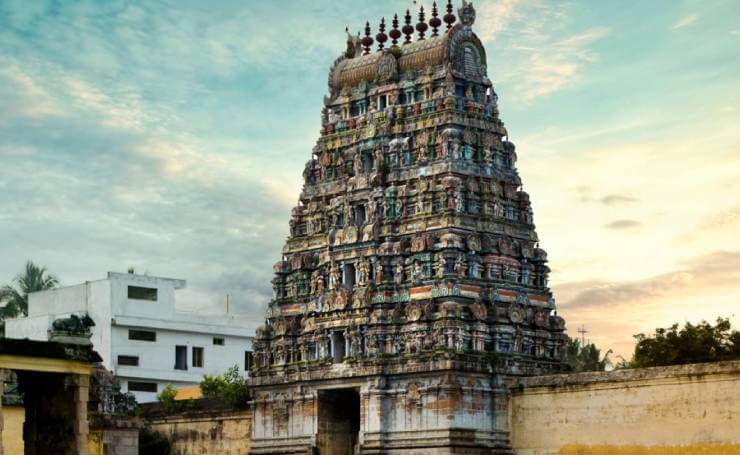
Located in the Nagapattinam District of Tamil Nadu, Mayuranathaswami temple is one of the very popular holy shrines of Lord Shiva. According to a legend, once Lord Shiva cursed Goddess Parvati and as a result Goddess Parvati was born as a Peahen.
In order to atone for her mistakes, she worshipped at Mayiladuthurai and Mylapore in the form of a Mayur (Peahen). Pleased by her devotion Lord Shiva forgave her. Lord Shiva is worshipped as Mayuranathar and Goddess Parvati as Abhayambikai.
Small shrines of Nataraja, Durga, and Ganesha also adorn the temple premises to shower their divine blessings to the devotees.
Don’t forget to take a holy dip in the month of November- December (Aippasi) as it is considered auspicious. The one who takes bath in this pond is free from karmic backlog and sins according to the beliefs.
Popular Festival – Mayura Natyajali festival – It’s an annual festival held every year.
Temple Timings – 5:30 am-12:00 am and 4:00pm-8:30pm
Other Interesting Blog to Read
Kapaleeshwarar Temple, Chennai – Legend of Peacock Continues
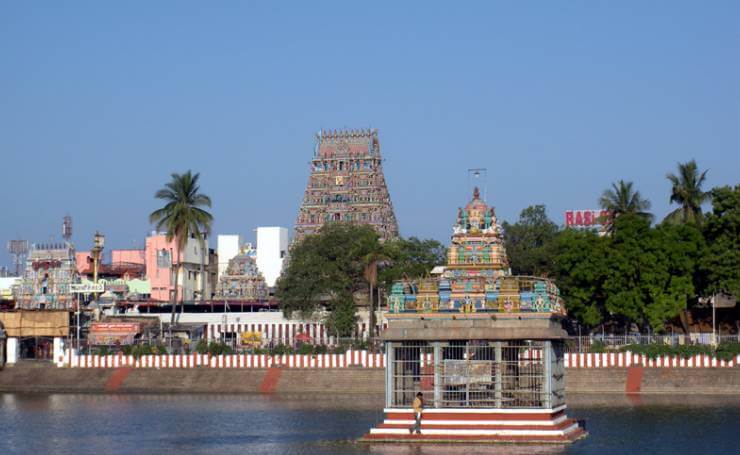
Located in Mylapore district of Chennai, the ‘Kapaleeshwarar Temple’ was built under the reign of the Pallava Kings during 7th century CE. However, the temple structure that stands today dates back to 16th century CE owing to the fact that the original structure was devastated by the Portuguese and it was in the 16th century that the Vijayanagara Kings brought the temple back to its pristine splendour.
Rainbow Coloured Pillars
Dedicated to Lord Shiva who is revered here in the form of Kapaleeshwarar, the temple is one of the significant pilgrimage sites in Tamil Nadu for the Shaivites attracting hordes of devotees every day. Adorned with a huge rainbow-coloured Gopuram, pillared halls and a water body; Kapaleeshwarar Temple presents a fine example of a true Dravidian style of architecture.
Once upon a Time…
According to mythological legends, Goddess Parvati in the form of peahen or ‘Mayil’ as said in Tamil, performed a huge penance for Lord Shiva at this pious site. That is the reason, a small shrine of Goddess Parvati who is revered here in the form of Karpagambal is also present in the temple complex besides the main sanctum of Lord Shiva who is enshrined in the form of Shivling.
The Karpagambal shrine attracts huge crowds on Fridays when the presiding deity is bedecked with a garland of gold coins. Another interesting site of the temple is a small shrine under the old Punnai Tree in the courtyard that depicts the story of Goddess Parvati in the form of a peahen worshipping the Shivling.
One of the most sacred sites in Tamil Nadu, a visit here is sure to provide you with an unmatched experience of solace and divinity.
Other Interesting Blog to Read
Monolithic Rock Temples, Mahabalipuram- Rocking Rocks of the Divine
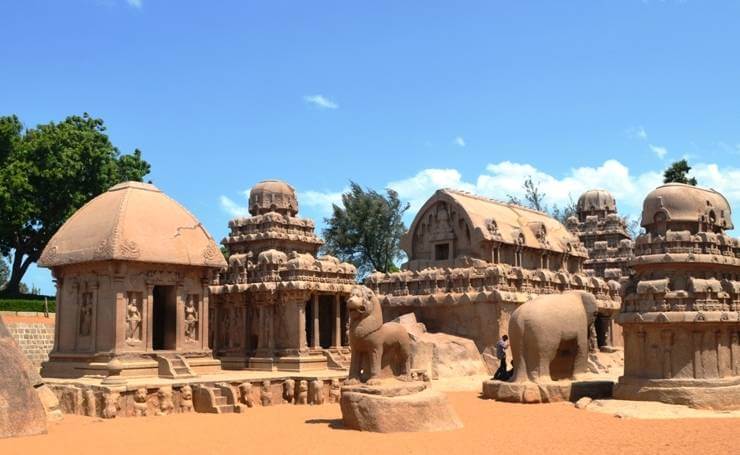
Known as the ancient temple town, Mahabalipuram is a UNESCO World Heritage site that dates back to 7th century and is believed to have been built under the reign of Pallava dynasty. The town today stands as a testimony to some of India’s greatest architectural and sculptural achievements.
Major Highlights
- The main highlight of this temple town is its five monolithic rock-cut temples in the form of ‘Pancha Rathas’ or chariots. Each ratha is believed to have been dedicated to a Pandava brother from the times of Mahabharata.
- With every ratha carved in different shape and size, adorning captivating sculptures of animals, humans and gods; the architecture of these structures provide you with a deep insight into the architectural skills of the sculptors during the Pallava rule.
- Another great attraction of the town is the beautiful ‘Shore Temple’ embellished with intricate carvings and sculptures. Unlike other temples of the region that have been carved out of monolithic rocks, this temple was made from granite blocks and stands as one of the earliest examples of stone built temples in South India.
- The inner sanctum of the temple enshrines a Shivling. Also, a shrine dedicated to Lord Vishnu with an image of him reclining on the Sheshnag can be seen adorning the inner walls.
- The outer courtyard of the temple is decorated with multiple sculptures of Nandi bull. Located on the shores of Bay of Bengal overlooking the azure waters of the never-ending ocean, the temple not only showcases the artistic brilliance of the artisans of the bygone times but also the royal taste of the Pallava kings.
- A visit to Mahabalipuram is incomplete without witnessing its gigantic bas-relief works carved out of granite blocks dating back to the 7th century. Most famous amongst all reliefs is the depiction of River Ganges’ descent to earth with Lord Shiva shown taking her in his matted locks.
- Another amazingly beautiful relief work is of ‘Arjuna’s Penance’ depicting Arjuna undertaking a penance in order to obtain a powerful weapon from Lord Shiva that can lead to Pandavas victory over Kauravas in the battle of Mahabharata.
Temple Timings- 6:00am to 6:00pm
Other Interesting Blog to Read
Papanasam Temple, Tirunelveli – Destroyer of Sins
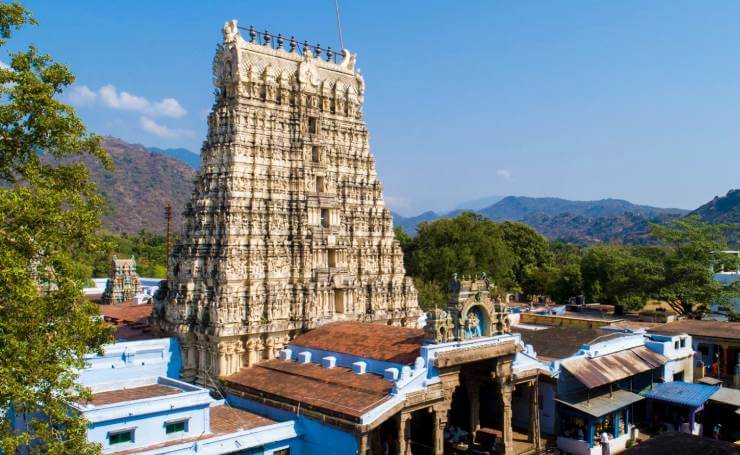
The Divine temple of Papanasam at Tirunelveli is dedicated to Lord Shiva. No one knows when this temple came into existence. According to a legend, Once Lord Shiva standing between the horns of Nandi gave his divine darshan to sage Patanjali and Vyaghrapada at the place where this temple stands today.
Another legend says that Lord Indra killed the son of Venus- Shukracharya who was performing yagna for demons. Lord Indra incurred the sin of Brahmahathi Dosha. To get rid of this sin he worshipped Lord Shiva, it is here at Papanasam Indra came to pray and only by entering its borders he got rid of his sin. Devotees from all over the world came here to atone for their sins and get the divine blessings of Lord Shiva.
Popular Festival – Brahmotsavam Festival (April- May) and Thaipoosam – (Jan- Feb)
Major Highlights
- River Tambiraparani from Pothigai Hills flows by this Temple is a fascinating site to behold.
- Picturesque views of Dams, water bodies, Agastyar waterfall and mountain range add to the serenity of this place.
- Kalakad mundanthurai Tiger reserve is one of the best places to visit here.
Temple Timings- 6:30 to 1:00pm and 4:30 to 8:00pm
Other Interesting Blog to Read
Srivilliputhur Andal Temple – Virudhunagar – Divine Love and Eternal Grace
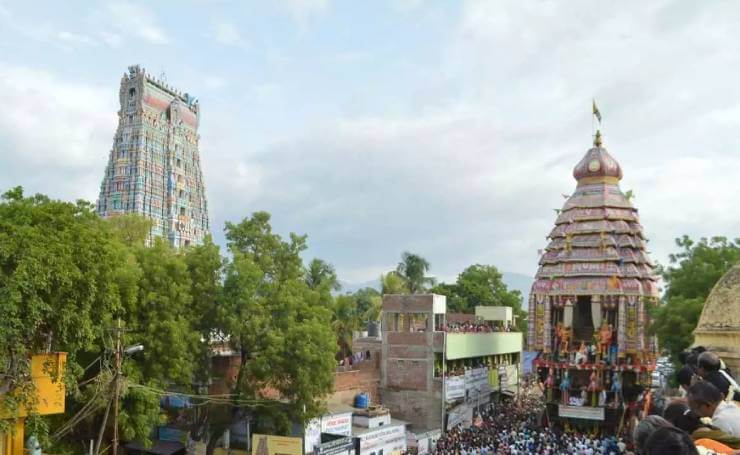
Srivilliputhur Andal Temple is one of the most popular shrines of Lord Vishnu. This divine temple dates back to the 8th century BC. It was built by King Villi who saw Lord Vishnu in his dreams asking him to build a temple dedicated to him. The temple is associated with the legend of two saints Periyalwar and Andal.
Interesting Legend
As per the legends Andal who is an incarnation of Goddess Earth – Bhoodevi, was 5 years old was found in the temple garden Nandanavanam of Periyalwar. As he had no children of his own, he adopted Andal. Once Andal wore the garland in the absence of Periyalwar meant for Lord Vadabadrasayee and then replaced the garland in the flower basket.
Periyalwar, unaware of this, offered the garland to Lord Vadabadrasayee. This continued for some time. One day Periyalwar caught Andal and was extremely upset by seeing her doing this sacrilegious act. At that very night Lord Vadabadrasayee appeared in Periyalwar’s dreams and said he would only accept Andal’s garland. Since then, the garland adorn by Andal is offered to Lord Vadabadrasayee.
Center of Attraction
- This temple has the largest gopuram in Tamil Nadu and it is also used by Tamil Nadu Government as its emblem.
- The shrine of Lord Vatapatrasayi (Vishnu) is in the Northeast direction of the temple and Goddess Andal’s (Laxmi) Shrine is in the Southwest direction.
- Aadippoorem , the birthday of Andal is the most popular festival celebrated in the month of July- August.
Devotees from all over the world visit this sacred shrine to get the divine blessing of Lord Vishnu and Andal and embrace solace and divine bliss.
Temple timings- 4:00am to 1:00pm and 4:00to 8:30pm
Other Interesting Blog to Read
Nagaraja Temple, Nagercoil – Legend of Naga
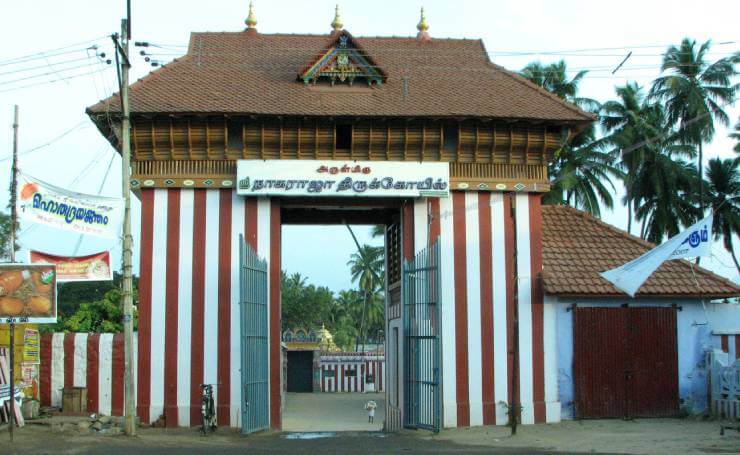
Located in the Nagercoil town of Kanyakumari district in Tamil Nadu, the ‘Nagaraja Temple’ is dedicated to the serpent king Vasuki. The presiding deity of this temple is the five-headed Naga God and is visited by hordes of devotees, especially on Sundays when a special Pooja is performed offering milk and turmeric to the deity.
Highlights
The temple sees an uncountable footfall of people suffering from Naga Dosha during the Tamil month of Avani (August and September) when some distinct rituals are performed for 12 days.
Delightful Legends of significance
According to folk tales and legends, once a village girl was cutting grass in the area when all of a sudden, she noticed blood oozing out of her axe after accidentally hitting a stone. She hurriedly went to the village and brought a few villagers here, out of which one villager recognized the stone as an idol of a five headed snake.
Thereafter, the temple dedicated to Nagaraja was built with its walls made of mud and roof made of coconut leaves. The main sanctum of the temple still has these mud walls and thatched roof with the small stone idol of Nagaraja placed on the soil. The soil underneath the idol remains wet as it is believed that the blood is still oozing out of the deity till date. It is believed that this soil holds special powers and can cure any skin ailments; the soil is also given as prasadam to the visitors of the temple.
Temple Architecture
The architecture of the temple is quite simple with scores of sculptures and images of different snakes adorning the walls, trees and pond around. The main sanctum enshrines the deity and is guarded by two huge statues of five-headed serpents. Inside the temple premises, you will also find Shivling and idol of Vishnu on Anant Shayana position.
One of the very unique temples in India located amidst tranquil and peaceful settings, a visit here is sure to leave you with a blissful experience.
Temple Timings – 5:00am to 11:30am and 5:00pm to 8:00pm
Other Interesting Blog to Read
Kumari Amman Temple, Kanyakumari – 3000 Years Old Divine Destination
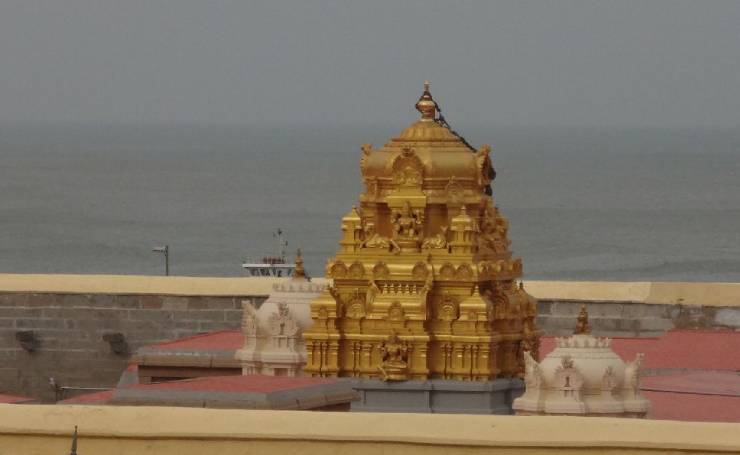
Located on the peninsula of Kanyakumari in Tamil Nadu, the ‘Kumari Amman Temple’ is dedicated to the virgin Goddess Kanya Kumari, an avatar of Goddess Shakti. Dating back to 3000 years, the temple sits on the serene confluence of Arabian Sea, Indian Ocean and Bay of Bengal. The idol of the presiding deity is in the form of a charming young girl with rosary in her right hand.
Let’s travel back in time
As per mythological beliefs, in Puranic times, the demon king, Banasura obtained a boon from Lord Shiva that he could only be vanquished by a virgin.
With this boon in hand, he caused great agony to Devas who in turn worshipped Goddess Parvati to get them relieved from the harassment of the demon king.
As an answer to the prayers of Devas, Goddess Parvati appeared in the form of a young girl and performed a penance for Lord Shiva on the confluence of these three oceans to kill Banasura.
Enchanted with the beauty of KanyaKumari, Banasura tried to force her into marriage that resulted in a fierce battle ending in his death.
Relieved of the atrocities of Banasura, a temple was built here dedicated to Devi Kanya Kumari by Lord Parshuram. The idol of the deity is believed to be the same that was installed by Parshuram.
The nose ring adorned by the deity has another story associated; it is believed that the diamonds of the nose ring are so bright that in the past, few ships sailing in the sea mistook the brilliance of these diamonds as light from a lighthouse resulting in their wreckage upon the nearby rocks. Since those accidents, the eastern door (sea facing) of the temple remains closed.
One of the famous pilgrim destinations in Tamil Nadu, a visit to this temple is sure to leave you blessed with peace and prosperity.
Temple Timings- 4:30 am – 12:30 pm and 4:00 pm – 8:00 pm
Other Interesting Blog to Read
Thillai Nataraja Temple, Chidambaram- Be one with the God
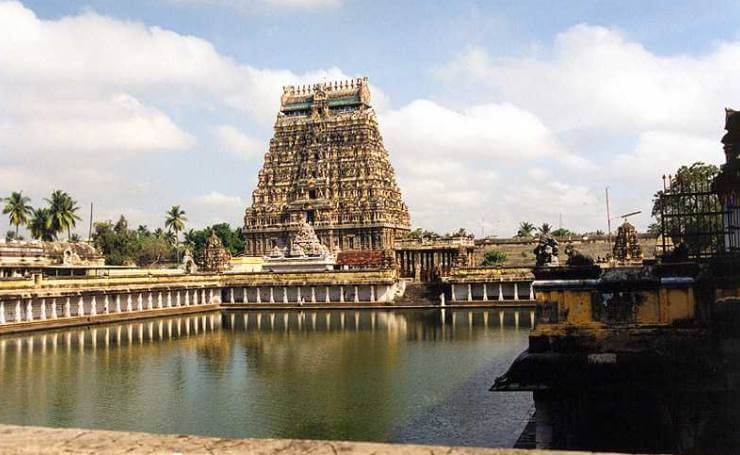
Dedicated to Lord Shiva in the form of Nataraja or the cosmic dancer, the ‘Thillai Nataraja Temple’ is one of the most ancient temples of Tamil Nadu known for both religious and architectural significance.<>
Panchabhuta
The temple is believed to have been built during the time of Pallava rule in the 11th century and further renovations were made during Cholas, Pandyas and Vijayanagara reign. The Nataraja Temple is also one of the ‘Panchabhuta Sthalas’ with each one dedicated to five elements of universe – earth, air, water, fire and space; this temple signifies the fifth element, space.
What’s in it for you?
- The place where the temple sits is believed to be the centre of earth’s magnetic field. The main sanctum known as Chitsabha, houses the deity of Nataraja and Sivakamasundri (Nataraja’s consort).
- The roof of Chitsabha is made of gold and is believed to have been built during the Chola rule. The temple also has a shrine for Sivakamasundri known as the Sivakami Amman Temple and a 1000 pillared hall designed in the form of a chariot.
- Dating back to the Chola period, the temple and the hall are adorned with figures of dancers, drummers and musicians on the walls.
- The lofty gopurams of the temple ornamented with carvings of Hindu gods, various manifestations of Lord Shiva and dancers representing 108 postures of Bharatnatyam, are also a sight to behold.
One of the most significant temples for Shaivites, a visit here is sure to provide you with an inner peace and solace.
Temple Timings – 6.00 a.m. to 12.30 p.m. and from 4.30 p.m. to 10.00 p.m.
Other Interesting Blog to Read
Annamalaiyar Temple, Tiruvannamalai – Grandeur of Annamalai Hills
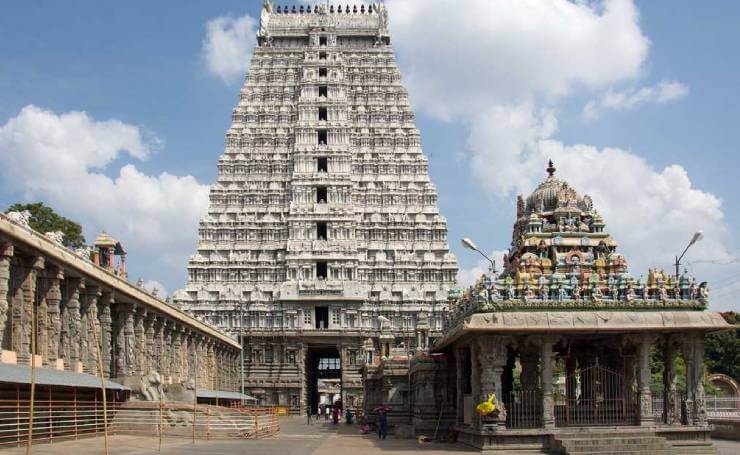
Another significant temple of the ‘Panchabhuta Sthalas’, the ‘Annamalaiyar Temple’ represents the element, fire and Lord Shiva here is revered in the form of Agni Lingam. The structure of the temple dates back to the 9th century when South India was under the rule of the Chola dynasty. Further additions were made to the temple by the Vijayanagara kings during the 15th century.
Architectural Marvel
Located on the foot of Annamalai hills, the temple spreads across an area of 25 acres and is built in typical Dravidian architectural style. The Rajagopuram of the temple stands tall at a height of 217 feet and can be seen from even a far-off distance.
This 11-tiered gopuram with intricate carvings showcases the artistic brilliance of the Vijayanagara artisans. Inside the temple complex, you will find 6 concentric enclosures with each enclosure housing shrines of various deities. The innermost enclosure has the sanctum that enshrines the Agni Lingam, the presiding deity of the temple.
Popular Festival
While you will see the temple always crowded with devotees and pilgrims travelling from far off corners of the world, the footfall gets multi-fold during the annual ‘Karthigai Deepam Festival’.
Huge processions accompanied with drummers, dancers and people dressed in vibrant attires, this festival provides you with a colourful spectacle also, giving you an opportunity to get an insight into different rituals and customs of South Indian temple festivals.
Temple timings- 5.30 am to 12:30 pm and 3:30 pm to 9:30 pm
Other Interesting Blogs to Read
Sripuram Golden Temple, Vellore – Solace and Eternal Peace
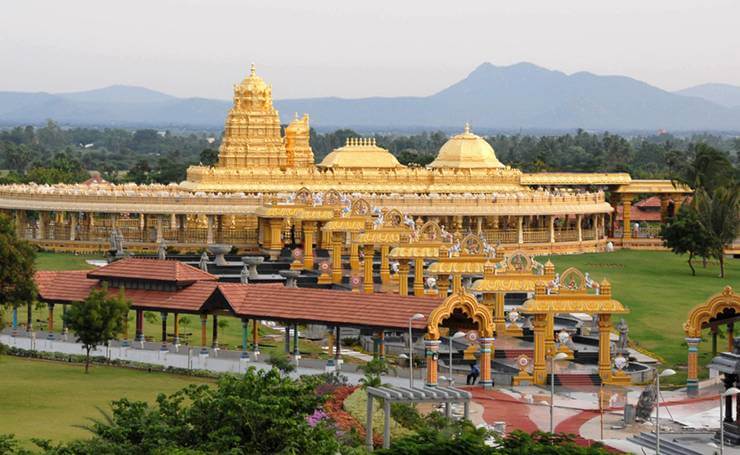
Situated on the hills of Malaikodi in the city of Vellore in Tamil Nadu, the ‘Sripuram Golden Temple’ is on the itineraries of almost all tourists on a trip to temples in South India. Standing tall in its stunning beauty and grandeur, the temple is truly a sight to behold. Built only recently in the year 2007, the temple is dedicated to Goddess Lakshmi (Goddess of wealth and prosperity) known as ‘Sri Lakshmi Narayani’.
Temple of Fascinating Beauty
The astoundingly outstanding carvings, sculptures, artwork and exquisite lighting work done by these artisans on the walls, ceiling and pillars of the temple is sure to leave you awestruck.
The glittering reflection of the temple in the water body surrounding it, during night is just beyond words and is sure to leave you enchanted with its hypnotising beauty.
What’s in it for you?
The pathways leading to the main temple are designed in the shape of a star with each pathway adorned with messages from the Gita, Bible and Quran. As you walk along the pathways, taking in the essence of these messages, you are enlightened with deep wisdom and knowledge.
Crossing the pathways and pillared halls, devotees get the darshans of Maha Lakshmi enshrined in the inner sanctum. You would be amazed to know that the deity of Maha Lakshmi itself is made of 70 kilograms of gold.
Temple Timings- 9:00am to 7:00pm
Other Interesting Blog to Read
Bala Murugan Temple, Siruvapuri – Serene drops of Spirituality
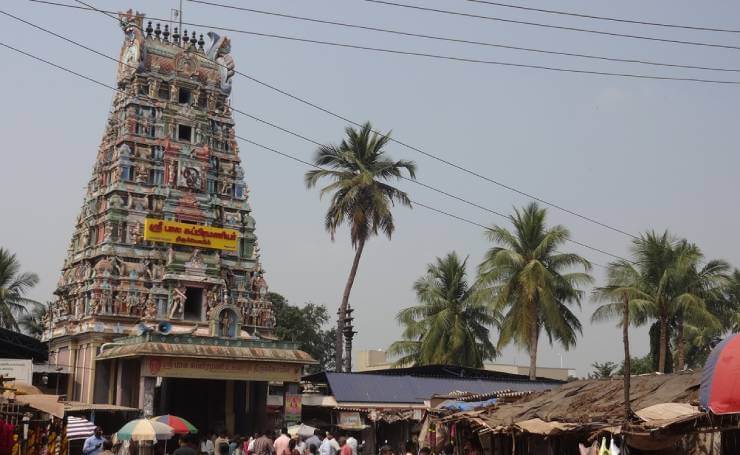
Dating back to 500 years, the ‘Bala Murugan Temple’ is dedicated to Lord Murugan also known as Kartikeya, son of Lord Shiva and Goddess Parvati. It is believed that Lord Murugan here fulfils the wishes of all his true devotees and therefore, the temple is visited by hundreds of people every day. The temple has a special place amongst the devotees wishing to purchase a new house or property.
Beliefs
The presiding deity of the temple is of Lord Murugan standing tall at a height of 4.5 feet. Outside the sanctum sanctorum, a sculpture of peacock made with green emerald is also held to be religiously significant.
A shrine in the temple complex, dedicated to Lord Murugan and his consort, Devi Valli depicted in wedlock, is visited by many devotees wishing to get married; praying here on the day of Poosam star is believed to be highly auspicious and fulfils the wish of marriage for all boys and girls.
One of the very popular holy shrines in Tamil Nadu, a visit to this temple provides you with a unique experience and a spiritual bliss.
Temple timings 7:00am to 12:00pm and 4:30pm to 8:00pm
In the End – Get Ready Divinely Inspired Travellers!
Tamil Nadu is home to thousands of temples that are visited by scores of pilgrims and tourists every year. The above list of temples is just a conglomeration of few of the state’s best pilgrimage sites. Providing you a great spiritual and divine experience, a trip to few of these temples makes for a ‘must visit’ if you are on a pilgrimage tour in South India.
Having said so, make sure before visiting these pious shrines, you are dressed appropriately and have a respectful attitude towards the religious sentiments of the people here. A last tip – beware of touts, guides and pickpockets. Wishing you a blissful and fulfilling spiritual journey!
Recommended Tour Packages
Like & Follow our social media accounts at Twitter, Facebook, Linkedin & Instagram for getting the latest updates & offers on holiday packages.
Disclaimer: We do not take credit for some of the licenced paid images used in our blogs, whether from Google Images, Fotolia & Shutterstock. All such images are the copyrights of their respective owners and we try to provide credit for them wherever we can. If, however, any copyright image has been used on our blog, the concerned person can either mail us directly to remove the image or provide credit to whomsoever the image may belong to.
Frequently Asked Questions
Q.What is the ticket price of Shore temple of Mahabalipuram?
For Indian the price is INR 10 and for Foreigners the price is INR 340 to visit the divine Shore Temple of Mahabalipuram.
Q.What is the oldest temple to visit in Tamil Nadu?
The oldest temple of Tamil Nadu is the Lord Murugan temple in Mahabalipuram. There is no evidence to prove this fact that it is the oldest temple but according to the ruins unearthed in 2005, there are two temple ruins that belong to the period Sangam and Pallava.
Q. What are the major festivals held at Ramanathaswamy Temple?
Some of the most popular festivals held at the sacred temple of Ramanathaswamy are -
- Mahashivratri
- Adi Ramalinga Prathistai
- Floating festival on Thai Poosam
- Adi Thirukalyanam
Q.Apart from the Meenakshi Temple, what are the other popular temples to visit in Madurai?
Apart from the divine Meenakshi Temple, some of the popular temples to Visit in Madurai are -
- Azhagar Kovil Temple
- Koodal Azhagar Temple
- Shri Solaimalai Murugan Temple
- Sri Mavoothu Velappar Temple
- Narasingam Yoga Narasimha Perumal Temple
- Thirupparamkunram Murugan Temple
- Sri Sri Radha Mathurapati Temple (ISKCON)
About the author
She is a candle who burns and melts in the chaos of infinity, from where her visceral whistles and leaves an imprint of desire in her heart to know the map of an Island where there are different sunrises and sunsets. Her curiosity brightens to conquer the hearts unrelieved and sometimes mysterious. Her name is - Pallavi Roy - A traveller by soul and a writer by Profession.

 +91-9212777225
+91-9212777225 Plan Your trip
Plan Your trip